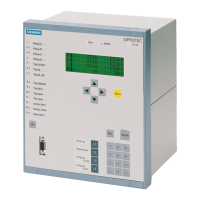2.18 Frequency Protection (optional)
343
7SD5 Manual
C53000-G1176-C169-1
Operating Ranges Frequency evaluation requires a measured quantity that can be processed. This
implies that at least a sufficiently high voltage is available and that the frequency of
this voltage is within the working range of the frequency protection.
The frequency protection selects automatically the largest of the phase-earth voltag-
es. If all three voltages are below the operating range of approx. 6 V (secondary), the
frequency cannot be determined. If the voltage sinks below this minimum value after
a frequency stage has picked up, the picked up element will drop out. This implies also
that all frequency stages will drop out after a line has been switched off (with voltage
transformers on line side).
When connecting a measuring voltage with a frequency outside the configured thresh-
old of a frequency element, the frequency protection is immediately ready to operate.
Since the filters of the frequency measurement must first go through a transient state,
the command output time may increase slightly (approx. 1 period). This is because a
frequency element picks up only if the frequency was outside the configured threshold
in five consecutive measurements.
The frequency range is from 25 Hz to 70 Hz. If the frequency leaves this operating
range, the frequency elements will drop out. If the frequency returns into the working
range, the measurement can be resumed provided that the measuring voltage too is
inside the working range. But if the measuring voltage is switched off, the picked up
element will drop out immediately.
Power Swings In interconnected networks, frequency deviations may also be caused by power
swings. Depending on the power swing frequency the mounting location of the device
and the setting of the frequency elements, power swings may cause the frequency
protection to pickup and even to trip. In such cases out-of-step trips can not be pre-
vented by operating the distance protection with power swing blocking (see also
Section 2.6). Rather, it is reasonable to block the frequency protection once power
swings are detected. This can be accomplished via binary inputs and binary outputs
or by corresponding logic operations using the user-defined logic (CFC). If, however,
the power swing frequencies are known, tripping of the frequency protection function
can also be avoided by adapting the delay times of the frequency protection corre-
spondingly.
Pickup/Tripping Figure 2-139 shows the logic diagram for the frequency protection function.
Once the frequency was reliably detected to be outside the configured thresholds of a
stage (above the setting value for f> elements or below for f< elements), a pickup
signal of the corresponding stage is generated. The decision is considered reliable if
5 measurements taken in intervals of
1
/
2
period yield one frequency outside the set
threshold.
After pickup, a delay time per element can be started. When the associated time has
elapsed, a trip command is issued. A picked up element drops out if the cause of the
pickup is no longer valid after 5 measurements or if the measuring voltage was
switched off or the frequency leaves the working range. When a frequency element
drops out, the tripping signal of of the corresponding frequency element is immediately
terminated, but the trip command is maintained for at least the minimum command du-
ration which was set for all tripping functions of the device.
Each of the four frequency elements can be blocked individually by binary inputs. The
blocking takes immediate effect. It is also possible to block the entire frequency pro-
tection function via binary input.
www . ElectricalPartManuals . com

